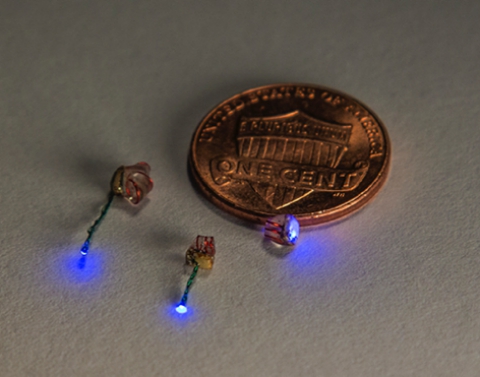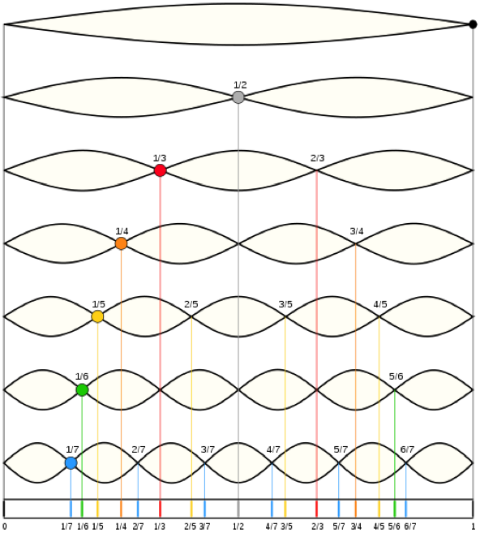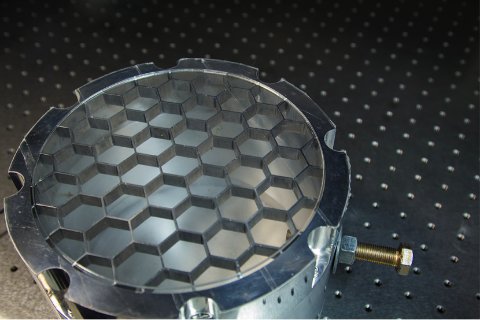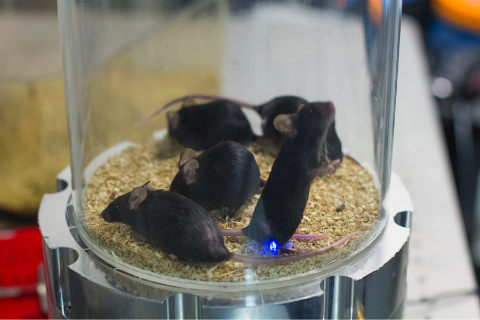Wireless Neural Implants
September 22, 2015
In joint efforts across disciplines, Stanford’s Bio-X team has created tiny devices that can be wirelessly powered, implanted, and used to trigger neurons as well as track the movements of a mouse, using the animal's own body to transfer energy! It is the first device capable of delivering optics-based nerve stimulation in a fully implantable format.1,2

Image Credit: Courtesy of Dr. Ada S.Y. Poon, Stanford
The Physics Behind Wireless
How do you power something without connecting it? The physics that allows wireless power has been around for a long time, but is only now reaching its full potential in a variety of arenas. Magnetic induction is the primary means of transferring energy from one area to another.
Electricity and magnetism are intertwined. Light, which is an electromagnetic wave, propagates because a changing electric field produces a magnetic field, and a changing magnetic field produces an electric field. A moving charge (electric current) produces a changing electric field that in turn creates a magnetic field. Similarly, a changing magnetic field near charges that are free to move, like those in a conductor, can induce a current.
When a changing magnetic field goes through a closed loop of wire, it induces a current in that loop. This bit of physics is used in motors: a current is supplied to a coil of wire (a solenoid, the technical name for the spring shape) in a magnetic field, creating magnetic repulsion that turns a rotor. This connection between electric and magnetic fields is also used in generators, but in reverse: generators require a rotor to be turned, which creates an electric current by moving a magnet in close proximity to a conducting coil. This effect can also be achieved by moving the coil, and keeping the magnet in place. (Remember, all motion is relative!) The electromagnetic properties of solenoids (loops of wire forming a cylindrical shape) are also utilized by transformers, which transfer energy from one coil to another, usually to increase or decrease the voltage.
You can thank transformers for all those big plugs on your laptops, cell phone chargers, and printers. Fundamentally, these devices are two helical coils of wire in close proximity (all within that big plug, which often contains other circuitry as well). As an alternating current goes through one coil (the one connected to the wall plug), it creates a continuously changing current that produces a continuously changing magnetic field. The changing magnetic field goes through the unattached secondary coil, producing an electric current through it, proportional to the number of coils. For more on this topic see our earlier article about wireless charging.3
Wireless Power and Implanted Devices
Although wireless power is not difficult or new, it requires proximity. Powering a small device with just the right amount of current to avoid overheating the area, on distance scales roughly the length of a mouse, is not so simple. This is where some real innovation shines through: Dr. Ada Poon decided that perhaps she could utilize the mouse in solving this problem. The size of an object is related to which frequencies will naturally resonate with it, and characteristics of the material also affect how well an electromagnetic wave will enter and travel through it. Living tissue is no different; as a result, all creatures have certain natural electromagnetic resonances, meaning they allow certain wavelengths to propagate through them, based on their size and composition.
As an analogy, consider plucking a guitar string. The string has a fixed length, and is clamped down at both ends. When the string is plucked to create a standing wave (one that we hear as a note played), only multiples of half-wavelengths that exactly fit along the length of the string will resonate, since the ends of the string can’t move. The waves that naturally fit, we would call natural resonances.

Natural resonances that occur on a string fixed at both ends, such as a guitar string.
Image Credit: Public Domain, via Wikimedia Commons
The mouse is roughly ellipsoidal, so one can estimate what frequencies would resonate within the body of the mouse. Dr. Poon did this calculation to determine how she could use the mouse to couple or carry the electromagnetic wave needed to power an implanted device, and how to design the device implanted. The result: a functional optogenetic implant with just a few loops of coil, and some other circuitry components.
She designed a mouse cage that has as its base a cylindrically-shaped radiofrequency resonant cavity, where the top of the cavity doubles as the cage’s floor. The dimensions of this cavity and the radiofrequency used are chosen based on the mouse’s characteristics, and determine how much energy gets coupled to it as radio waves are pumped into the cavity. In order to allow the mouse to couple to the field, some of the field has to get out of the cavity below, but not too much. To achieve this, the top of the radiofrequency cavity is made of a type of “mesh”, full of holes just smaller than the resonant wavelength of electromagnetic wave being coupled. This partial shielding allows only a small evanescent field to get through the mesh and into the plastic mouse enclosure above. An evanescent field is one that dies away over a very short distance.

Resonant cavity that makes up the base of the cage
Image Credit: Courtesy of Dr. Ada S.Y. Poon, Stanford.
When the mouse is placed inside, the mouse couples with the small evanescent field, creating a pathway to transmit the electromagnetic wave and the energy it carries. The mouse’s body then acts as a resonating cavity of its own, and the electromagnetic waves inside it can couple to the implanted device, transferring power to it. The localization of the field at the location of the mouse can also be measured, giving scientists the ability to “see” the mouse’s position remotely.
You can see the video here explaining this cage-mouse-device coupling:
How Will This Help Neuroscience?
In the past, studies of neural activities required implanting devices to deliver a voltage across a region of the brain, which could not target specific neurons and required a battery pack to operate. Alternatively, light could be used to trigger neural firing; neurons were first prepared by embedding special opsin proteins on the target nerves, then surgically placing an optical fiber in the neurons’ vicinity. The optical fiber, protruding from a mount on the animal’s skull, could then carry a light pulse to the interior of the mouse’s skull, where it could induce or prevent the firing of the opsin-treated neurons. For more information on light-controlled neurons please see our earlier article Mind Over Matter, Light Over Mind.
Although these devices gave great insight, they are bulky and inhibitory to the mice being studied. Finding a device that would allow the mouse to move about freely, and in a social environment, would provide richer information.
That's just what these new devices do.

Several mice socialize in the resonance cage. The LED visible on the mouse's back leg draws its power from the RF field below.
Image Credit: Courtesy of Dr. Ada S.Y. Poon, Stanford
Future Research and Development
The scientists note in their paper1 that this design currently works well only for small animals, but there is no reason why it could not be scaled up to longer wavelengths and lower frequencies for larger animals in larger contained areas. The researchers also note the possibility of adjusting the cavity to include water enclosures for swim tests, and/or for multiple mice interacting.
References
1. Ho, J.S., et. al, Self-Tracking Energy Transfer for Neural Stimulation in Untethered Mice, Phys. Rev. Applied, 4, 024001 (2015)
2. Adams, A. Stanford Engineers Develop a Wireless, Fully Implantable Device to Stimulate Nerves in Mice, Stanford News, 17 August 2015
3. Doss, H., Wirelessly Charged Electric Buses, Physics Central
—H.M. Doss














